Yan Jingzhou’s works in this exhibition present an overall tension structure interwoven with absurdist drama and modern literature. Between image and narrative, they touch upon subtle layers of human relationships to some extent, calling for ideals of equality and freedom, and delicately exploring the depths of emotion. Some pieces reveal themes of love and identity, others observe geopolitical relations, pay homage to the classics, or reinterpret the cultural genes of his hometown. His paintings resemble mirrors illuminated by many beams of reflected light, in which countless faces—those masked by social norms—shed their disguises one by one, silently telling their own monologues.
The precisely shaped and textured figure “Buster” transcends barriers of identity, wandering between a Kafkaesque absurd stage and a Shakespearean spectrum of humanity. Everyday scenes—building sandcastles by the sea, checking out at a register, swimming pools, trash bins—become meaningful “soliloquies.” The unseen elements—the rustling sound of digging sand, brief eye contact at the checkout, laughter when water splashes—reflect the defined gender roles; though the characters’ gazes may seem somewhat vacant, they reveal deep care, delicately sketching the beautiful coexistence between people. This “coexistence” is both warm and fragile, interpreting profound love within subtle tension.
In Buster Table, three characters sit around a poker table, with piled chips resembling a geopolitical map of power, metaphorically betting on fate. Works like Fake Nirvana™ and Thumbs Up Means Yes humorously peel back harsh truths with a playful game-like attitude, evoking political allegories reminiscent of Tony Kushner’s “Angels in America”: when chips become tools of power and cards the rhetoric of diplomacy, humanity’s wager in the game of desire is nothing but a fragile vision of peace. The essence of global politics may be a collective emotional crisis; how to break through this prosperous boundary remains an unknown and unresolved question.
Idioms such as “things happen no more than thrice,” “horses’ lips don’t match donkeys’ mouths,” “three’s a crowd,” and “the yellow bird is behind” cause the works to hover between the figurative and the metaphorical, enhancing the narrative quality and cultural affinity of the paintings. This fluid translation of cultural identity empowers the reflection of human society’s absurdities and contradictions through ordinary life fragments. The paintings go beyond simply expressing personal thoughts; their intrinsic narratives brim with literary charm, combining the tragicomic feel of Beckett’s “Waiting for Godot” and the incredible, faith-conflicted world of Kafka’s “The Metamorphosis”. Reason and absurdity confront each other here, expanding the works’ dimensions and sparking wisdom and philosophical insight.
Works such as Rush Hour, Pink Police, and Sugar-Coated Beast are filled with festive atmospheres, yet the characters’ expressions appear somewhat hollow and detached, as if experiencing an unspeakable loneliness amidst celebration. This emotional contradiction creates a stark contrast between surface joy and inner sorrow. Through these scenes, Yan Jingzhou explores the alienation of individuals in collective revelry in today’s society. Much like Eugene O’Neill’s play “The Iceman Cometh”, where characters seek brief escape in alcohol and gambling but cannot flee inner emptiness, human self-deception, despair, and the void of redemption are vividly portrayed. Yan uses the exaggerated expressions and vibrant colors of the “Busters” figures to present this heavy theme in a light, absurd form.
These images, both innocent and somewhat comical, symbolize the chaos and plurality of reality. Their existence carries irreconcilable conflicts and contradictions, yet also reveals the true nature of love: from subtle glances, silent care, ordinary tacit understanding, to fragile reliance, and the equal sharing by the railway tracks and brave expression under the rainbow. Diversity and profundity intertwine; love is like an improvised absurd performance, continuously emitting a hidden glow amid turmoil and redemption. It simply is—needing no proof or concealment—always softly murmuring in the human theater, gently helping to write the “virtual game.”
EXHIBITING WORKS
 Red Pill / Green PillAcrylic on canvas 160 x 106 cm 2025 | 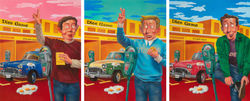 Eggstasy TriptychAcrylic and oil pastel on canvas 200 x 160 cm x 3 2025 | 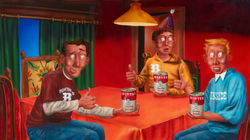 Thumbs Up Means YesAcrylic and oil pastel on canvas 160 x 284 cm 2025 |
|---|---|---|
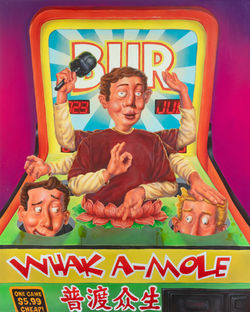 Fake Nirvana™Acrylic on canvas 200 x 160 cm 2025 | 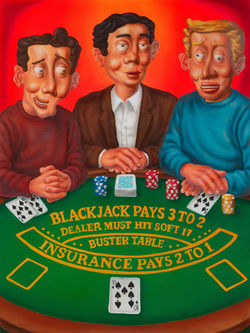 Buster TableAcrylic and oil pastel on canvas 200 x 150 cm 2025 | 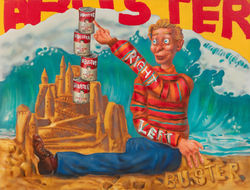 Sandcastles & Chicken SoupAcrylic and oil pastel on canvas 173 x 230 cm 2024 |
 The Faker and the FoolAcrylic and oil pastel on canvas 230 x 173 cm 2024 |  Spaghetti No.42Acrylic and oil pastel on canvas 160 x 200 cm 2025 |  Easter Christmas Bunny™Acrylic and oil pastel on canvas 200 x 192 cm 2024 |
 Rush HourAcrylic and oil pastel on canvas 225 x 173 cm 2025 |  March of the Team BAcrylic and oil pastel on canvas 185 x 220 cm 2024 | 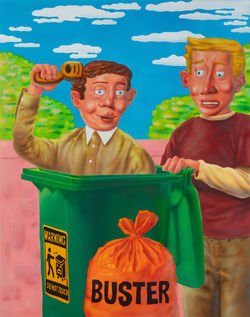 Garbage Day for BusterAcrylic on canvas 200 x 150 cm 2025 |
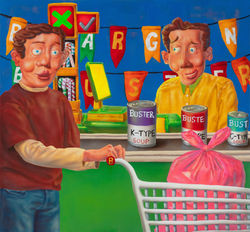 Which Type Am I?Acrylic and oil pastel on canvas 160 x 172 cm 2025 | 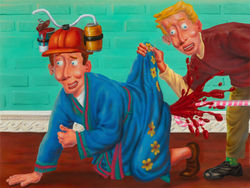 Bend Over, BuddyAcrylic on canvas 150 x 200 cm 2025 |  Silence, Shame, SalvationAcrylic and oil pastel on canvas 198 x 145 cm x 3 2024 |
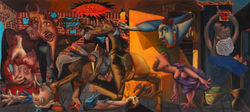 No Wall, No DarknessAcrylic and oil pastel on canvas 230 x 256 cm x 2 2024 | 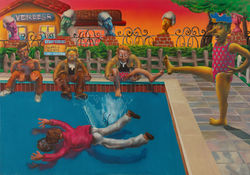 Club of the FallenAcrylic and oil pastel on canvas 214 x 305 cm 2024 | 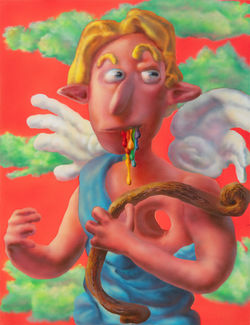 Spitting ProphecyAcrylic on canvas 120 x 92 cm 2024 |
 Pink PoliceAcrylic on canvas 120 x 86 cm 2024 |  Agree to DisagreeAcrylic on canvas 100 x 86 cm 2024 | 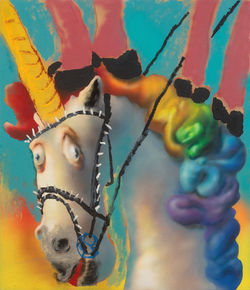 Sugar-Coated BeastAcrylic on canvas 110 x 107 cm 2024 |
 Faceless BlessingAcrylic on canvas 110 x 80 cm 2024 |
Artist

Yan Jingzhou
b. 1995, Handan, Hebei province, China
Lives and works in Beijing, China
Yan Jingzhou graduated from Hebei Normal University School of Arts and Design in 2018, from the Department of Oil Painting. He went on to study at the China Central Academy of Fine Arts, graduating in 2022 with a major in Oil Painting. Starting from 2024, he is pursuing a PhD degree at the China Central Academy of Fine Arts.
“Buster” runs through his entire body of work. It is not a character, nor the title of a series, but a way of seeing and building. It keeps a light tone without offering ease; it borrows the language of humor, only to withdraw the punchline at the last moment. Its aim is not to entertain, but to interrupt laughter halfway and leave a pause behind.
Yan does not assert positions, nor does he produce symbols. He simply pushes images to their threshold, allowing noise to remain within the structure. The tension in his work does not come from narrative—but from silence.
His exhibitions include: “Contact Zone,” Tang Contemporary Art, Beijing, China (2024); “Yan Jingzhou: All Around Buster Town,” Tang Contemporary Art, Beijing, China (2024); “Buster’ s Love,” Tang Contemporary Art, Bangkok, Thailand (2023); “Layered Skin,” Tang Contemporary Art, Hong Kong, China (2023); “First Encounter,” Yue Art Museum, Beijing, China (2022); “Jungle of All Forms,” Haihui Art Museum, Zhengzhou,China (2022); “The 9th Beijing International Art Biennale,” National Art Museum of China, Beijing, China(2022); “The 5th Poetic Living Festival ‘Poetry and Songs for Life’ Art Exhibition,” Tianqiao Performing Arts Center, Beijing, China (2020); “Xunxun Exhibition Series V - The Garden of Forking Paths,” Parkview Green Art Center, Beijing, China (2020).



